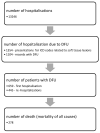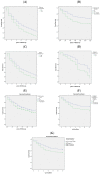Evaluating Classification Systems of Diabetic Foot Ulcer Severity: A 12-Year Retrospective Study on Factors Impacting Survival
- PMID: 37510519
- PMCID: PMC10379067
- DOI: 10.3390/healthcare11142077
Evaluating Classification Systems of Diabetic Foot Ulcer Severity: A 12-Year Retrospective Study on Factors Impacting Survival
Abstract
(1) Background: This study examines the survival of patients after their first presentation with diabetic foot ulcers (DFUs) to the regional Diabetes, Nutrition, and Metabolic Diseases Clinic within the Emergency Clinical Hospital "Sf. Spiridon", Iaşi, and analyzes the factors associated with this outcome. (2) Methods: In this retrospective study, patients with DFUs consecutively referred between 1 January 2007 and 31 December 2017 were followed up until 31 December 2020 (for 13 years). The study group included 659 subjects. (3) Results: During the study period, there were 278 deaths (42.2%) and the average survival time was 9 years. The length of hospitalization, diabetic nephropathy, chronic kidney disease, glomerular filtration rate, cardiovascular disease, hypertension, anemia, and DFU severity were the most significant contributors to the increase in mortality. Patients with severe ulcers, meaning DFUs involving the tendon, joint, or bone, had a higher mortality risk than those with superficial or pre-ulcerative lesions on initial presentation (Texas classification HR = 1.963, 95% CI: 1.063-3.617; Wagner-Meggitt classification HR = 1.889, 95% CI: 1.024-3.417, SINBAD Classification System and Score HR = 2.333, 95% CI: 1.258-4.326) after adjusting for confounding factors. (4) Conclusions: The findings of this study suggested that patients presenting with severe ulcers involving the tendon, joint, or bone exhibited a significantly higher risk of mortality, even when potential confounders were taken into consideration.
Keywords: SINBAD classification system and score; University of Texas Staging System; Wagner–Meggitt classification; diabetic foot ulcers; mortality; survival.
Conflict of interest statement
The authors declare no conflict of interest.
Figures



Similar articles
-
Survival Prediction in Diabetic Foot Ulcers: A Machine Learning Approach.J Clin Med. 2023 Sep 7;12(18):5816. doi: 10.3390/jcm12185816. J Clin Med. 2023. PMID: 37762756 Free PMC article.
-
Comparison of five systems of classification of diabetic foot ulcers and predictive factors for amputation.Int Wound J. 2017 Jun;14(3):537-545. doi: 10.1111/iwj.12642. Epub 2016 Oct 10. Int Wound J. 2017. PMID: 27723246 Free PMC article.
-
Mortality in Patients with Diabetic Foot Ulcers: Causes, Risk Factors, and Their Association with Evolution and Severity of Ulcer.J Clin Med. 2020 Sep 18;9(9):3009. doi: 10.3390/jcm9093009. J Clin Med. 2020. PMID: 32961974 Free PMC article.
-
Diabetic foot ulcer, the effect of resource-poor environments on healing time and direct cost: A cohort study during Syrian crisis.Int Wound J. 2022 Mar;19(3):531-537. doi: 10.1111/iwj.13651. Epub 2021 Jul 4. Int Wound J. 2022. PMID: 34219380 Free PMC article. Review.
-
Influencing factors for the recurrence of diabetic foot ulcers: A meta-analysis.Int Wound J. 2023 May;20(5):1762-1775. doi: 10.1111/iwj.14017. Epub 2022 Nov 17. Int Wound J. 2023. PMID: 36385501 Free PMC article. Review.
Cited by
-
Survival Prediction in Diabetic Foot Ulcers: A Machine Learning Approach.J Clin Med. 2023 Sep 7;12(18):5816. doi: 10.3390/jcm12185816. J Clin Med. 2023. PMID: 37762756 Free PMC article.
-
The promising approach of 3D bioprinting for diabetic foot ulcer treatment: A concise review of recent developments.Heliyon. 2024 Aug 23;10(17):e36707. doi: 10.1016/j.heliyon.2024.e36707. eCollection 2024 Sep 15. Heliyon. 2024. PMID: 39281506 Free PMC article. Review.
-
Commentary on "Pedal Medial Arterial Calcification in Diabetic Foot Ulcers: A Significant Risk Factor of Amputation and Mortality".J Diabetes. 2025 Mar;17(3):e70071. doi: 10.1111/1753-0407.70071. J Diabetes. 2025. PMID: 40038843 Free PMC article. No abstract available.
-
Comments on "Non-classical monocytes frequency and serum vitamin D3 levels are linked to diabetic foot ulcer associated with peripheral artery disease".J Diabetes Investig. 2025 Feb;16(2):350-351. doi: 10.1111/jdi.14356. Epub 2024 Nov 26. J Diabetes Investig. 2025. PMID: 39592435 Free PMC article. No abstract available.
-
The Relationship Between Plasma Fibrinogen Levels and the Severity of Diabetic Foot Ulcers in Diabetic Patients.Cureus. 2025 Mar 24;17(3):e81118. doi: 10.7759/cureus.81118. eCollection 2025 Mar. Cureus. 2025. PMID: 40151482 Free PMC article.
References
-
- Jain A.K.C. A Simple New Classification for Diabetic Foot Ulcers. Med. Sci. 2015;4:2109–2120. doi: 10.5455/medscience.2014.03.8215. - DOI
LinkOut - more resources
Full Text Sources

